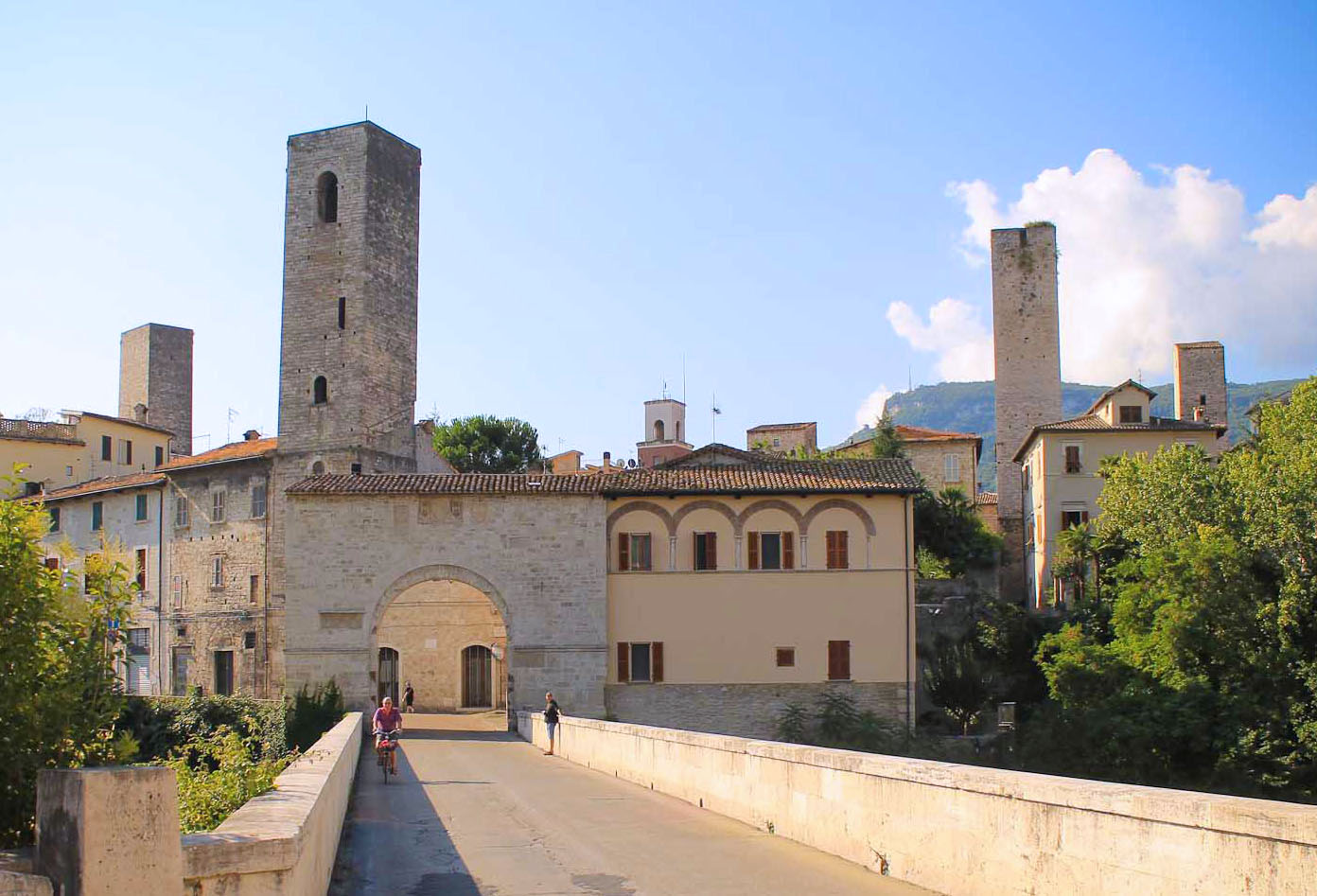Ascoli Piceno is the southern-most province within the region of Le Marche in central Italy. It is bordered by the Adriatic Sea to the east, the Province of Macerata to the north, while to the south are the regions of Umbria and Abruzzo. The area slopes down from the Apennines to the sea, passing through the Sibilline Mountains that rise along the border with Umbria. The mountains of the interior give way to hills in the east that descend to the coast, punctuated by orchards and fields, which turn the landscape into a palette of colors.
The coastline, narrow and sandy, lies between the Chienti and Tronto Rivers, interspersed with charming seaside towns, such as San Benedetto del Tronto, known for its long, sandy beach, wide promenades and lovely palm trees. Grottammare is also known for its fine beach, while Cupra Marittima has a milder climate that enables tropical vegetation to grow.
The capital city, Ascoli Piceno, was founded by the Italic Sabine tribe in the 9th century BC. It was located along the Via Salaria – the vital salt road that connected Latium to the salt production areas on the Adriatic coast. In 268 BC, Ascoli Piceno became a civitas foederata – a federated city that had nominal independence from Rome. In 91 BC, together with other cities in central Italy, it revolted against Rome, but after two years was reconquered during the Battle of Asculum. Much of the city was destroyed in the process, but as a consolation, its inhabitants were made citizens of Rome.
It was more than 500 years later that as the Roman Empire crumbled, Ascoli was ravaged by the Ostrogoths. In the sixth century it was conquered by the Lombards who ruled the area as part of the Duchy of Spoleto for the next two centuries. Next came the Franks, who ruled under the Holy Roman Empire, but during the late medieval period, Ascoli was fought over by the Malatesta and Sforza families, ultimately to be ruled again by Rome, this time at the hand of the Pope, rather than the emperors of centuries past. In 1860, it was annexed as part of Le Marche into the newly unified Kingdom of Italy.
Ascoli Piceno is one of Le Marche’s most refined and attractive towns. Its historic center is unusual for this part of Italy. It is flat in contrast to many of the communities in the province which are steeply-sloped hillside towns. Visitors find Ascoli to be a charming pocket of medieval streets, punctuated by grand churches and photogenic piazzas. There is a sense of grandeur, especially in and around the central squares of Piazza del Popolo and Piazza Arringo.
The characteristic buildings, streets and piazzas tell the story of centuries of history. From the facades of its medieval buildings to its ancient maze of streets and trails, Ascoli Piceno is a town of art, culture and strong traditions. As visitors view the structures, there is a harmonious mix of styles, due to the widespread use of travertine marble for everything from simple buildings to palaces; from churches to the pavement of its piazzas.
Piazza del Popolo has been the main square of the city since Roman times. The elegant rectangular space is flanked by the Chiesa di San Francesco and the 13th century Palazzo dei Capitani del Popolo. The ‘Captain’s Palace’ served as the seat of the city’s Pontifical Governors for centuries and today houses municipal offices and art exhibitions. The statue of Pope Paul III above the main entrance recognizes the Pontiff’s success at quelling a rebellion that erupted during the turbulent 16th century Protestant Reformation. Chiesa di San Francesco is a monumental church with its southern flank edging onto Piazza del Popolo. It is named after St. Francis, who is said to have visited Ascoli in 1215. Construction began in 1258, but took almost three centuries, only reaching completion in 1549.
Piazza Arringo was once the political heart of town, containing the Cathedral and Bishop’s Palace. The Cattedrale di Sant’Emidio, topped by a pair of mismatched towers, was built in the 16th century and is dedicated to the city’s patron saint. Its most prized possession is the three-section Polyptych of Saint Emidio, dating to 1473 by Venetian painter Carlo Crivelli. Still in its original frame, it has not been moved from its location in over 500 years. Next to the Cattedrale is the Romanesque-style octagonal battistero (baptistry), which has remained unchanged since it was reconstructed in the 12th century.
Many of Ascoli’s museums are concentrated in this part of the city, giving rise to the piazza’s nickname: Museum Square. Here visitors can marvel at the works contained within the Pinacoteca Civica – the second-largest art gallery in Le Marche. It is set within the 17th century Palazzo Comunale. The palace’s aristocratic halls are lined with outstanding works of art and sculpture by major artists which include Titian, Carlo Crivelli and Guido Reni. Highlights include Titian’s Saint Francis Receiving the Stigmata and a stunning embroidered 13th century Papal cape worn by Ascoli-born Pope Nicholas IV.
While each of the city’s many Romanesque and Gothic churches offer interesting histories and artwork, make sure to visit the 14th century Chiesa di San Pietro Martire and its Reliquario della Santa Spina, a gilded silver reliquary containing a thorn from Christ’s crown.
Ascoli’s historic center is an architectural gem. Once home to over 200 towers, almost 50 still remain. At 1300 feet in height, Torre degli Ercolani is the city’s tallest tower. Abutting it is the Palazzetto Longobardo, a 12th century Lombard-Romanesque defensive position and just to the north is the well-preserved Ponte Romano, a single-arched Roman bridge.
Ascoli Piceno also possesses a long-established theatrical tradition, as can be seen from the many theaters built in the 19th Century, including the Filarmonici, Ventidio Basso and the San Francesco di Paola Auditorium.
If you happen to visit the city in the first week in August, you will be treated to the pageantry surrounding the feast day of Saint Emidio. Over 1,500 people dressed in Renaissance costume parade through the historical center. The first Sunday of August is reserved for the Quintana, a jousting competition capping a weekend of celebrations. The joust itself is a raucous community affair during which many of the town’s 60,000 residents pack the grandstands and cheer on one of the six participants, each representing one of the town’s neighborhoods or sestieri. The games and joust involve the riders performing various feats on horseback, armed with lances, demonstrating awe-inspiring accuracy in an effort to win the grand prize.
Not far from the city lies Mont Ascensione, a destination for pilgrimages during the Middle Ages. The mountain still sees thousands of the faithful climb it each year on Ascension Thursday, as the statue of the Madonna da Polesio is carried to the church at the mountaintop.
If traveling from Ascoli to San Benedetto del Tronto on the coast, visitors will pass through numerous small towns. Along the way is Offida, known for its 15th century fortress and the hill town of Ripatransone, whose lofty perch provides magnificent panoramic views of the landscape. Wherever one visits in Ascoli Piceno, the splendor of Medieval Italy is on display in the historic, yet timeless province.





